Accepted Scientific Name: Copiapoa fiedleriana (K.Schum.) Backeb. in Backeb. & F.M.Knuth
Kaktus-ABC [Backeb. & Knuth] 280. 1936 [12 Feb 1936] Backeb., F.M.Knuth

Copiapoa pepiniana var. fiedleriana (Copiapoa fiedleriana) Photo by: Carolina González
Blooming habit at Huasco in coastal Atacama desert of northern Chile. The distinguishing characteristic of this species is a prominent chin-like protuberance below the areole, more pronounced than in any other species of Copiapoa.
Origin and Habitat: Copiapoa fiedlerianaSN|1328]]SN|1328]] is endemic to Chile, where it occurs in Atacama, around Huasco to north of Carrizal Bajo. Extent of occurrence of approximately 800 km2. C. fiedleriana was originally described from the sea shore at Huasco, near the mouth of the valley in which Nicolasa is situated.
Altitude range: It grows at elevations of 0 to 600 m asl.
Habitat and Ecology: The species grows not along the coast but in dry coastal hills (lomas costeras) overlooking the lower reaches of the Huasco valley, where it forms clumps of dark-bodied, spherical heads. The area is rich in other cactus species with Eriosyce villosaSN|2370]]SN|3030]], Eriosyce napinaSN|3030]]SN|2370]], Eulycbnia acida and Echinopsis coquimbanaSN|7511]]SN|7511]] growing in association. The species is overall decreasing even if locally abundant (there are several hundreds of individuals), and there is a continuing decline of habitat quality and the number of mature individuals due to the effect of off-road vehicles, urbanization and industry in the species range.
Synonyms:
See all synonyms of Copiapoa fiedleriana
back
Accepted name in llifle Database:Copiapoa fiedleriana (K.Schum.) Backeb. in Backeb. & F.M.KnuthKaktus-ABC [Backeb. & Knuth] 280. 1936 [12 Feb 1936]Synonymy: 11
back
Description: Copiapoa fiedlerianaSN|1328]]SN|1328]], first described by Schumann as Echinocactus fiedlerianusSN|1114]]SN|1329]] in 1903, was included in Copiapoa by Backeberg in 1935 and then reduced to a variety of Copiapoa coquimbanaSN|1336]]SN|1348]] by Hoffmann in 1989. It is a strongly spined solitary to many-stemmed grey succulent of unusual form which you could describe as intermediate between Copiapoa coquimbanaSN|1348]]SN|1348]] and Copiapoa megarhiza var. echinataSN|1348]]SN|1336]], which occurs further north. The distinguishing characteristic of this species is a prominent protuberance below the areole, more pronounced than in any other species of Copiapoa. Typical plants from Huasco usually lack central spines, but it is quite variable and plants with or without central spines are found close to each other even in the some pupulation.
Derivation of specific name: The specific epithet honors the German master carpenter and cactus lover Rudolf Fiedler from Berlin.
Roots: Large, napiform, fleshy.
Stems: Globose, not elongated, grey-green to brown, 5-8 cm tall and in diameter. Cespitose from the base, forming dense cushions.
Ribs: 15-20, straight, deeply crenate, laterally compressed, conspicuously tuberculate below the areoles.
Areoles: Round to oval 4-7 mm long, grey, 20 mm apart.
Spines: Blackish or brown, greyish with age.
Central spines: Usually absent (if present usually 1 to 4 porrect and stiff similar in size and colour to the radials).
Radial spines: 4-8, needle-like, rigid, straight to slightly curved, 8-30 mm long.
Flowers: Yellow, 2.5-3 cm long. Inner tepals lemon-yellow, outer tepals with a red central stripe on the tip.
Fruits: Globose 10-15 mm in diameter, greenish with few long reddish scales.
Seeds: c. 1.5 mm long.
Taxonomy note. Copiapoa fiedlerianaSN|1328]]SN|1328]] is possibly the same plant as Echinocactus cupreatusSN|1329]]SN|1114]] Poselger ex Hildmann (1885), which was based on a cultivated plant of unknown origin, but interestingly the description made reference to protuberances, so this, together with body colour, suggests that it might that it might have been this plant.
Subspecies, varieties, forms and cultivars of plants belonging to the Copiapoa fiedleriana group
 Copiapoa echinata F.Ritter: ( = fiedleriana) Plant noticeable for its strongly tuberculate ribs and pruinose epidermis, the large tap-root suggest it is related with Copiapoa megarhiza.
Copiapoa echinata F.Ritter: ( = fiedleriana) Plant noticeable for its strongly tuberculate ribs and pruinose epidermis, the large tap-root suggest it is related with Copiapoa megarhiza.- Copiapoa echinata var. borealis F.Ritter: ( = fiedleriana) Plants from the northern areal.
- Copiapoa echinata var. pulla F.Ritter: ( = fiedleriana) Distingushed for the brown coloured epidermis.
 Copiapoa fiedleriana (K.Schum.) Backeb. in Backeb. & F.M.Knuth: Plants solitary or branched with large, fleshy roots. Stems globose, gray-green 5-8 cm tallwith tuberculate ribs. It has 4-8 radial spines blackish or greyish-brown up to 3 cm long. Central spines usually absent.
Copiapoa fiedleriana (K.Schum.) Backeb. in Backeb. & F.M.Knuth: Plants solitary or branched with large, fleshy roots. Stems globose, gray-green 5-8 cm tallwith tuberculate ribs. It has 4-8 radial spines blackish or greyish-brown up to 3 cm long. Central spines usually absent.- Copiapoa intermedia F.Ritter ex Backeb.: ( = fiedleriana )
- Copiapoa totoralensis F.Ritter: (same as Copiapoa echinata ?)
Bibliography: Major references and further lectures
1) Graham Charles “Copiapoa. The Cactus file Handbook 4” Cirio Pub. Services, 1999
2) Faundez, L., Guerrero, P., Walter, H.E. & Saldivia, P. 2013. Copiapoa fiedleriana. The IUCN Red List of Threatened Species 2013: e.T152115A598694. http://dx.doi.org/10.2305/IUCN.UK.2013-1.RLTS.T152115A598694.en. Downloaded on 19 February 2016.
3) F. Ritter “Kakteen in Sudamerika” Volume 3. 1980
4) A. Hoffmann, H. Walter “Cactáceas en la flora Silvestre de Chile” Ediciones Fundacion Claudio Gay, Santiago, Chile. Second Edition. 2004
5) Edward Anderson “The Cactus family” Timber Press, Incorporated, 2001
6) James Cullen, Sabina G. Knees, H. Suzanne Cubey “The European Garden Flora Flowering Plants: A Manual for the Identification of Plants Cultivated in Europe, Both Out-of-Doors and Under Glass” Cambridge University Press, 11/Aug/2011
7) David R Hunt; Nigel P Taylor; Graham Charles; International Cactaceae Systematics Group. "The New Cactus Lexicon" dh books, 2006
8) N. L. Britton, J. N. Rose “The Cactaceae. Descriptions and Illustrations of Plants of the Cactus Family.” Volume 3, The Carnegie Institution of Washington, Washington 1922
9) Curt Backeberg. “Die Cactaceae” volume 3, 1959
10) Curt Backeberg, Frederik Marcus Knuth: “Kaktus-ABC. En haandbog for fagfolk og amatører.” Kopenhagen 1936
11) Florencia Señoret Espinosa, Juan Pablo Acosta Ramos “Guía de Campo Cactáceas Nativas De Chile” Corporación Chilena de la Madera (CORMA) 2013 Retrieved 02 February 2016 from <http://www.corma.cl/_file/material/cactaceas_chilenas_2013.pdf>
 Habit at Huasco in coastal Atacama desert of northern Chile. (Copiapoa fiedleriana) Photo by: Carolina González
Habit at Huasco in coastal Atacama desert of northern Chile. (Copiapoa fiedleriana) Photo by: Carolina González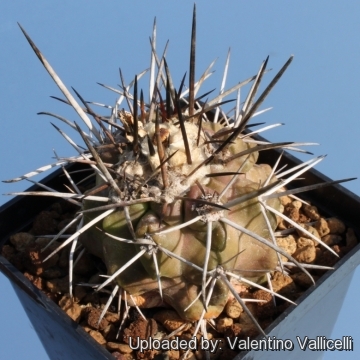 Copiapoa pepiniana var. fiedleriana (Copiapoa fiedleriana) Photo by: Valentino Vallicelli
Copiapoa pepiniana var. fiedleriana (Copiapoa fiedleriana) Photo by: Valentino Vallicelli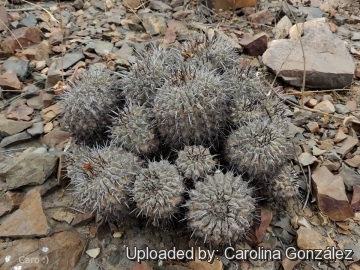 Habit at Huasco in coastal Atacama desert of northern Chile. (Copiapoa fiedleriana) Photo by: Carolina González
Habit at Huasco in coastal Atacama desert of northern Chile. (Copiapoa fiedleriana) Photo by: Carolina González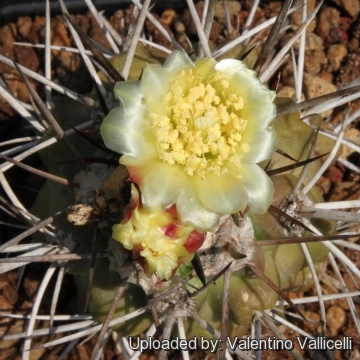 Copiapoa pepiniana var. fiedleriana (Copiapoa fiedleriana) Photo by: Valentino Vallicelli
Copiapoa pepiniana var. fiedleriana (Copiapoa fiedleriana) Photo by: Valentino Vallicelli Habit at Huasco in coastal Atacama desert of northern Chile. (Copiapoa fiedleriana) Photo by: Carolina González
Habit at Huasco in coastal Atacama desert of northern Chile. (Copiapoa fiedleriana) Photo by: Carolina González - KK172 (Collector: Karel Kníže) Locality: Nicolasa, Chile. Altitude: 500m (Copiapoa fiedleriana) Photo by: Valentino Vallicelli
- KK172 (Collector: Karel Kníže) Locality: Nicolasa, Chile. Altitude: 500m (Copiapoa fiedleriana) Photo by: Valentino Vallicelli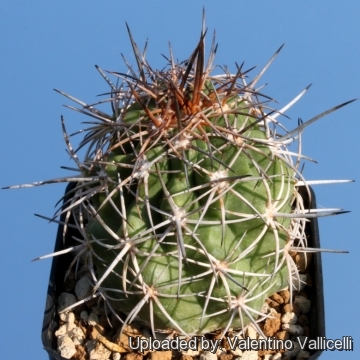 WM093 north of Huasco (Copiapoa fiedleriana) Photo by: Valentino Vallicelli
WM093 north of Huasco (Copiapoa fiedleriana) Photo by: Valentino Vallicelli Copiapoa pepiniana var. fiedleriana (Copiapoa fiedleriana) Photo by: Valentino Vallicelli
Copiapoa pepiniana var. fiedleriana (Copiapoa fiedleriana) Photo by: Valentino VallicelliCultivation and Propagation: This species need full sun otherwise the bodies tended to elongate in cultivation, but should be protected from excessive heat and sun in summer, Require light watering, good drainage, and deep pot to accommodate tap root. Keep warm and dry in winter to avoid rot. Frost tolerance 0°C.
Propagation: Seeds (offsets rarely), Grafting is often used to speed growth rate and to create a back-up to plants in collection.
Your Photos
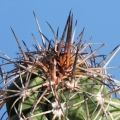
by Valentino Vallicelli




















